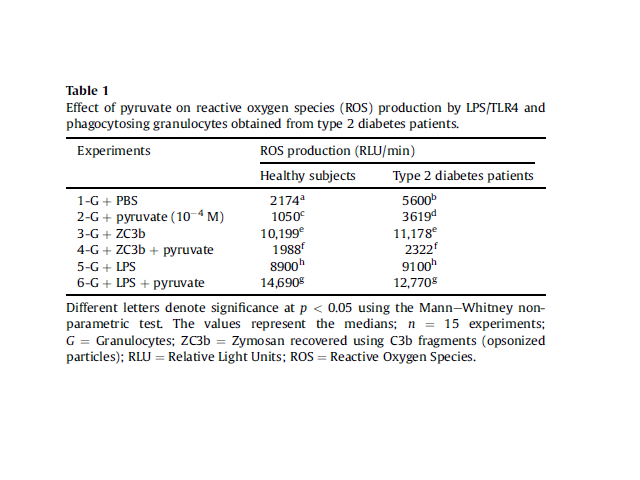Absence of pyruvate anti-oxidant effect on granulocytes stimulated toll-like receptors
Keywords:
Type 2 diabetes , Pyruvate , ROS , TLR4 , GranulocytesAbstract
Aim & background: Pyruvate is considered as an anti-inflammatory and anti-oxidant produced from glucose metabolism. We examined the effects of sodium pyruvate on reactive oxygen species (ROS) production induced by opsonized particles in phagocytosing or toll-like receptor 4 (TLR4)-stimulated granulocytes obtained from type 2 diabetic (T2DM) patients compared with those from healthy individuals. Methods: Luminol-dependent chemiluminescence was used to quantify the ROS generated. The phagocytosis by granulocytes obtained from T2DM patients or healthy individuals was evaluated in the absence of stimulation and in the presence of opsonized particles (zymosan complex recovered using the complement fragment C3b, ZC3b) or LPS as a TLR4 activator. Pyruvate (10-4 M) markedly inhibited ROS generation in unstimulated and ZC3b-stimulated granulocytes from T2DM patients and healthy individuals. Results: Our results showed 370.0% and 199.0% activation of ROS generation during phagocytosis in healthy subjects and T2DM patients, respectively. In the presence of pyruvate, these percentages were reduced to 81.0% and 80.0%, respectively. Thus, pyruvate exhibited similar suppressive activity during granulocyte phagocytosis in healthy individuals and T2DM patients (p > 0.05). In contrast, pyruvate did not inhibit or down-regulate ROS generation in granulocytes stimulated with LPS. LPS-induced ROS production in granulocytes from healthy subjects (309%) and T2DM patients (62.5%). In the presence of pyruvate, the ROS generation in LPS-stimulated granulocytes was greater (64.0%) in the cells obtained from T2DM patients compared with cells obtained from healthy individuals (38.0%) (p < 0.05; chi-square test). Conclusion: The dual effect of pyruvate might be associated with a metabolic signaling pathway that depends on the oxidizing profile of the target cell. However, the effects of pyruvate must be further studied before using this compound as an anti-inflammatory or anti-oxidant therapeutic resource.
Downloads
Metrics





